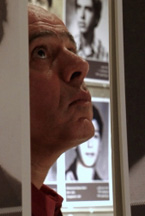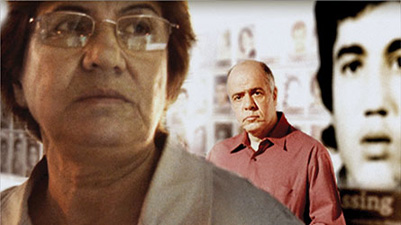
(Sleepless Nights just screened at the 2013 True/False Film Fest.)
A beguiling act of cinematic interventionism, Eliane Raheb’s debut Sleepless Nights is a true force. Focusing on two powerful characters, the film is a mysterious-yet-lucid meditation on the way a society processes and moves on from civil war.
Assaad Shaftari, a former high-ranking intelligence officer in a Lebanese Christian militia, has come clean about the hundreds of deaths and disappearances that he was directly or indirectly responsible for, and in the process, has become something of a media darling. With kind, sad eyes, Shaftari is presented at once as simple father and murderer, creating a shifting relationship with the viewer. How much you sympathize with the man changes with each scene, echoing the complex nature of the human tragedy that was Lebanon at war in the 1980s.
Meanwhile, Maryam Saiidi is the mother of a young missing fighter, on the other side of the religious and class-based conflict. Beginning the movie by refusing to “talk about the past,” Saiidi eventually opens up and her rage over losing her son builds until she confronts Shaftari in an amazing sequence set in a museum for remembrance. The confrontation is upsetting and unnerving, a still-grieving mother exploding on the man who may be responsible, while he stands silent, frozen among the hanging photos of missing boys of war.
 The most intriguing aspect of this electrifying scene might be that it was clearly staged by the filmmaker. Throughout the film, Raheb is onscreen or heard, pleading with her subjects to share more, questioning—even badgering—them to explore aspects of their stories that they clearly want to avoid because they are too painful or politically troubling. “I don’t want to talk about that, Eliane,” is frequently heard, almost always followed by a crucial bit of knowledge or emotional vulnerability. Raheb is nearly unwavering in her intervention; her confrontational presence is a crowbar, prying open the bin of social memory.
The most intriguing aspect of this electrifying scene might be that it was clearly staged by the filmmaker. Throughout the film, Raheb is onscreen or heard, pleading with her subjects to share more, questioning—even badgering—them to explore aspects of their stories that they clearly want to avoid because they are too painful or politically troubling. “I don’t want to talk about that, Eliane,” is frequently heard, almost always followed by a crucial bit of knowledge or emotional vulnerability. Raheb is nearly unwavering in her intervention; her confrontational presence is a crowbar, prying open the bin of social memory.
Images are repeated and multiple angles of moments emerge. The editing is often original, quick and structural, creating the sensation of looking at all sides at once, a formal technique that becomes a metaphor for a nation coping with memories of violence. Several striking minor characters introduce new angles to the prism, creating a stunningly complex portrait of post-civil war collective psychosis. A viewer learns less than experiences, despite the fact that this is a documentary built on conversations and the uses of words.
Sleepless Nights spins to an almost surreal final act, as the performative aspects of cultural “remembrance” are shown in clown shows and cheesy songs. Finally, the search for the mother’s son provides a final, stunning moment of strange clarity. For a society to move on, the bodies must be found, but once they are, what does it mean? Although its length and dependence on talking can be somewhat exhausting, Raheb’s film is in many ways reminiscent of late-20th century European art cinema. A movie of uncommon complexity, Sleepless Nights is a harrowing exploration of the slow, ambiguous march of history and memory.
— Robert Greene










